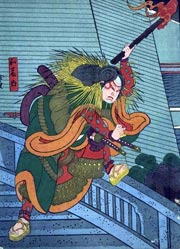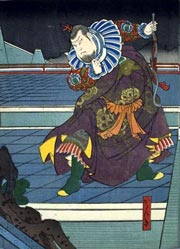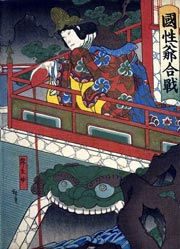| KOKUSEN'YA GASSEN |
| Play title | Kokusen'ya Gassen |
||||||||||||||||||
| Author | Chikamatsu Monzaemon | ||||||||||||||||||
| History |
The 5 acts puppet theater drama "Kokusen'ya Gassen" was written by Chikamatsu Monzaemon and performed for the first time at the Takemotoza in the 11th lunar month of 1715. It was extremely successful and was extended up to the 3rd lunar month of 1717 (the longest run in Japan theater history, all genres taken into account). It was adapted for Kabuki for the first time in Fall 1716 in Kyôto at Miyako Mandayû's theater [casting]. "Kokusen'ya Gassen" was staged for the first time in Ôsaka in the 11th lunar month of 1716, simultaneously in 2 theaters, the Ônishi no Shibai and the Higashi no Shibai. It was produced by the zamoto Sawamura Sôjûrô for the nadai Matsumoto Nazaemon in the former theater, starring the actors Anegawa Shinshirô I (Watônai) and Sawamura Sôjûrô (Kanki). It was produced by the zamoto Arashi Gosaburô for the nadai Ôsaka Kuzaemon in the latter theater, starring the actors Sakurayama Shirosaburô I (Watônai), Sanogawa Mangiku (Kinshôjo), Takenaka Tôzaburô (Kanki), Kirinoya Gonjûrô I (Rôikkan) and Kirinami Takie (Watônai's mother). "Kokusen'ya Gassen" was staged for the first time in Edo in the 5th lunar month of 1717, produced simultaneously in the 3 Edo Kabuki theaters (Nakamuraza / Ichimuraza / Moritaza). It is worthy noting that it was the first Kabuki adaptation of a puppet theater play in Edo. |
||||||||||||||||||
| Structure |
The core of this play is made up of 3 acts and 5 scenes: |
||||||||||||||||||
|
|||||||||||||||||||
| Key words |
Aragoto Dattan Ennosuke Shijûhassen Ennosuke Shin'enshutsu Jûshû Gidayû Kyôgen Kokusai Kekkon Meitei |
||||||||||||||||||
| Summary |
The play is somewhat exotic as most of it is set in China, and so the costumes and sets are particularly colorful. However, it is also a rather jingoistic play, with the theme of Japanese supremacy, and contains a couple of moments that although performed humorously, made me feel uncomfortable-the forced shaving of Chinese soldiers' heads to match the Japanese style of the time, and the imposition of Japanese names on them. As the play opens we are in the court of the Ming Emperor of China, and the Emperor is approached by two advisors, the faithful Gosankei and the evil Ritôten. Gosankei advises extreme caution in China's relations with the nation of Dattan, whereas Ritôten says they should have closer relations, and they even owe them a debt because Dattan supplied the Ming with grain during the previous year's famine, a fact about which the Emperor knows nothing. To prove his gratitude to Dattan, Ritôten plucks out his left eye and hands it to the Dattan representative. This action convinces the Emperor of Ritôten's faithfulness, but a short time later Ritôten returns and cuts down the emperor, taunting him for his stupidity in losing his empire for the price of one eye! Gosankei saves the Emperor's sister, Princess Sendan and sends her off with his wife. The pregnant Empress dies, but Gosankei saves her baby and sacrifices his own new-born son instead so that the enemy will find an infant corpse and believe the heir is dead. For safety Princess Sendan has been put on a boat, which arrives on the shores of Japan near the home of Rôikkan, who was exiled from China more than 20 years earlier. He lives with his Japanese wife, Nagisa and son, Watônai. After hearing Sendan's story, Watônai and his parents decide to travel to China to help restore the Ming dynasty. They land near a dense bamboo forest full of tigers. One of Ritôten's retainers, Antaijin, has been ordered to hunt down a tiger, but Watônai not only defeats the tiger but also Antaijin and his men, and has them lead him to Shishigajô Castle, where Kinshôjo, Watônai's half-sister, and her husband, General Kanki, live. Kinshôjo is overjoyed to be reunited with her father, but in Kanki's absence, she cannot let them into the castle. Finally, it is agreed that her step-mother, Nagisa, be alllowed inside as long as she is bound first. She promises to put their case to her husband; if she is successful she will release white powder into the river; if not, red powder, and they should come and take Nagisa and return to Japan. For complicated reasons, Kanki refuses to be aligned with Watônai and Kinshôjo releases red into the river, but it is her own blood. Nagisa also kills herself to join her step-daughter and this shocking result brings Watônai and Kanki together in partnership at last against the Dattan forces. Watônai accepts the new name of Kokusen'ya and together they defeat Ritôten and restore the Ming dynasty and child Emperor. Text courtesy of Jean Wilson (January 1999) |
||||||||||||||||||
 |
 |
 |
|
The actors Arashi Rikan III, Onoe Tamizô II and Arashi Rikaku II playing the roles of Watônai, Kanki and Kinshôjo in the drama "Kokusen'ya Gassen", which was staged at the Kado no Shibai in the 1st lunar month of 1859 (print made by Utagawa Hirosada) |
||
|
|
| Contact | Main | Top | Updates | Actors | Plays | Playwrights | Programs | Links | FAQ | Glossary | Chronology | Illustrations | Prints | Characters | Derivatives | Theaters | Coming soon | News |